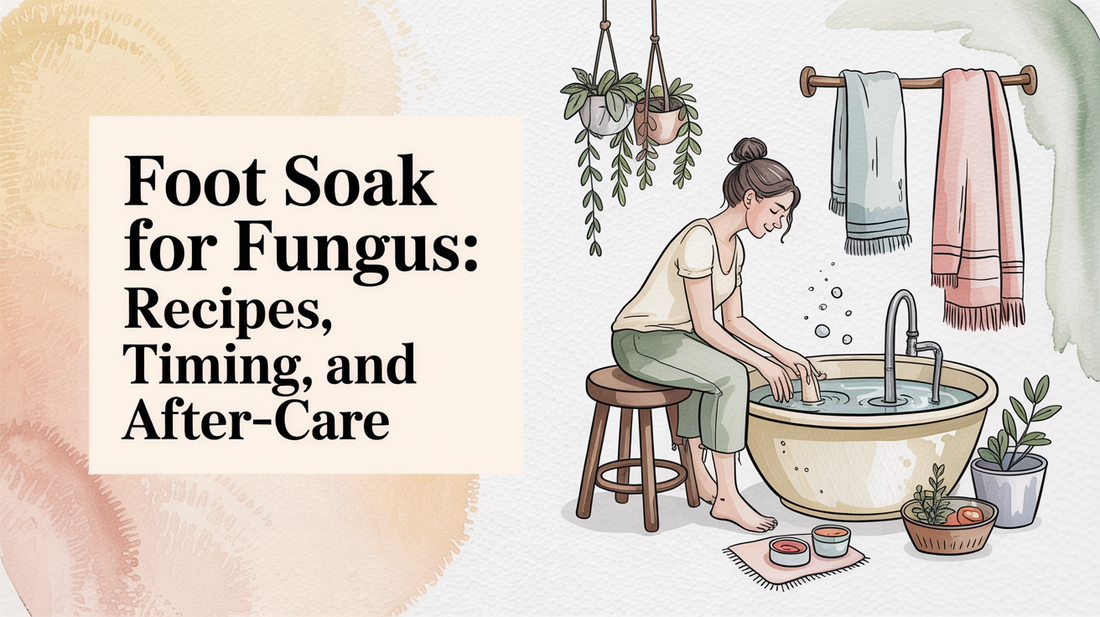Foot Soak for Fungus: Recipes, Timing, and After‑Care
foot soak for fungus, antifungal foot soak recipes, foot soak routine — If you've been struggling with foot fungus, you're not alone. This post will discuss the benefits of a foot soak for fungus and share effective antifungal foot soak recipes and a foot soak routine to help alleviate discomfort. With three clear sections, you'll find actionable steps to start tonight.
When Foot Soaks Help—and When They Don’t 🧭
Foot soaks can be a gentle way to address mild fungal infections, such as athlete's foot between the toes. However, they may not be effective for more severe cases or nail fungus. The soothing soak can help soften the skin and reduce unpleasant odors, creating a less favorable environment for fungal growth.
It's essential to understand that while soaks can be beneficial, they are not a standalone solution. Combining foot soaks with proper hygiene, antifungal treatments, and lifestyle adjustments can enhance their effectiveness. For those with diabetes, open wounds, or weakened immune systems, it's advisable to consult a healthcare provider before trying foot soaks.
- Best for mild infections like athlete's foot.
- Helps soften skin and reduce odors.
- Not a solitary solution—pair with good hygiene.
- Consult healthcare providers if you have health concerns.
- Avoid overuse to prevent skin dryness.
Try It Tonight: Calm, Fresh Feet ✨
- Wash feet with warm water and mild cleanser; dry thoroughly between toes.
- Apply a small amount of Kissable Feet where needed; massage until absorbed.
- Let skin breathe; slip on breathable socks if desired. Patch-test first if you’re new to this foot cream.
DIY Soak Ideas and How Long to Soak ✨
Creating your own antifungal foot soaks can be a fun and effective way to utilize natural ingredients with antimicrobial properties. Some popular recipes include apple cider vinegar (mixed at a 1:2 ratio with water), tea tree oil (a few drops in warm water), Epsom salt (1/2 cup per gallon), and baking soda (1/4 cup per quart of water). Timing is crucial; soaking for about 15-20 minutes is optimal, as too short a time may not yield results, while too long can irritate the skin.
The water temperature should be warm, not hot, to prevent burns, especially for those with reduced sensitivity. If you have an active fungal infection, soaking daily is recommended, reducing to 2-3 times weekly for maintenance. Always make sure to dry your feet thoroughly after soaking, particularly between the toes, to avoid retaining moisture that can worsen fungal conditions.
- Apple cider vinegar, tea tree oil, Epsom salt, and baking soda are great DIY soak ingredients.
- Soak for 15-20 minutes for best results.
- Ensure water is warm to avoid burns.
- Soak daily for active infections, then reduce frequency.
- Thoroughly dry feet after soaking to prevent moisture retention.
Why We Recommend a Gentle Helper 🌿
After your soak, applying Kissable Feet foot cream can significantly enhance results. This cream absorbs quickly and offers a soothing sensation without any sting. With a blend of tea tree, coconut, and calendula, it’s crafted for comfort and is easy to incorporate into your nightly routine.
- Fast-absorbing comfort—non-greasy finish.
- Gentle sensation suited for sensitive, overworked feet.
- Clean-leaning, bedtime-friendly scent.
Seal in results with Jane Vine Kissable Feet Foot Cream 🔍
Post-soak foot care is key for maintaining your results and preventing reinfection. Quality foot creams are essential in this routine. Applying a moisturizing foot cream immediately after soaking can help lock in the benefits while the skin is still damp and more receptive to absorption.
Choose foot creams that include helpful ingredients such as urea, lactic acid, or tea tree oil for both hydration and antimicrobial properties. Proper application involves massaging the cream into clean, dry feet, focusing on dry areas that may be prone to cracking. Regular use of a good foot cream can help maintain the skin barrier, keeping your feet healthy and preventing entry points for fungi.
- Apply foot cream right after soaking for maximum benefits.
- Look for moisturizing and antimicrobial ingredients.
- Massage into clean, dry feet, focusing on problem areas.
- Regular use helps maintain a healthy skin barrier.
- Choose fast-absorbing, non-greasy formulas.

